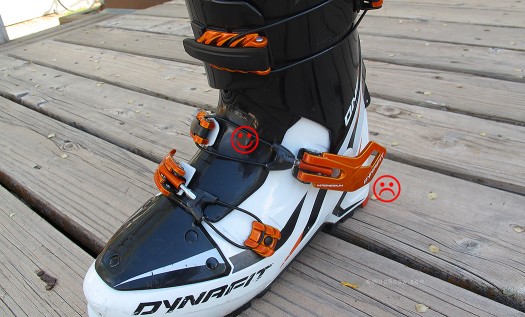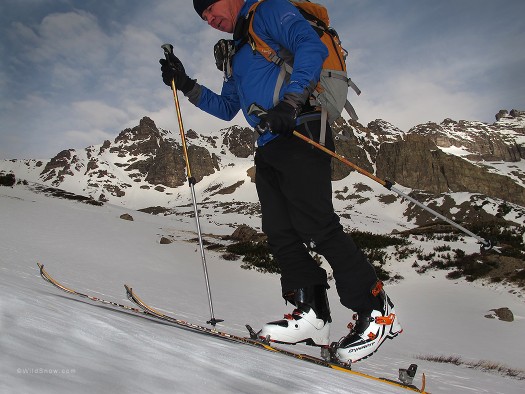Editor’s note: Due to the difficulty of using the word ‘One’ as a product model name, we took the liberty of writing it all caps in this review. Please know we’re not shouting the boot name in your left ear, we’re simply trying to make our writing easier to read.
Yeah, it’s a weird name for a boot, but the moniker makes sense eventually. The idea: this is the “one” boot you need, and closes with “one” upper buckle that also latches the cuff in “one” motion. Ok, ok, enough with the PR hype.

ONE combines a fairly conventional 'shoe' with Dynafit's attempt to disrupt the way backcountry skiing boot uppers are usually constructed. Click images to enlarge.
Getting real:
(Or as real as one can get with a pre-production sample, anyway…) The ONE boot model from Dynafit is an attempt to mate a more conventional lower shell (meaning it has the DIN standard ski touring boot dimensions) with the cuff and latch system of the now legendary TLT5 models. We found the cuff/latch system to work as promised, so ditch the power strap and you can switch these guys between alpine and tour mode with little more than a flick of your ever supple wrist. More, due to the pivoting spoiler (‘Driving Spoiler’) that’s part of the latch system, rearward articulation continues to be superb.
Ditching the power strap? More outlier blasphemy from WildSnow.com? Well, the ONE boot cuff is high and stiff, so perhaps. Give it a shot. Power strap dependency is like meth addiction; you may never really get over it — but remission is liberating — especially as you nail first tracks while everyone else is trying to untangle the velcro from their pants cuffs.

When I saw this, I heard angels singing on high. An instep buckle that actually holds your instep instead of crushing down on your arch. But we do question the location of the buckle, as we wonder if it'll have problems with opening up while snow climbing.

Cuff latch is the now legendary Dynafit 'Ultra-Lock' super simple but super effective. One motion to close and latch the cuff, hence the 'ONE' boot (that is if you assign the power strap to your junk bin.)

By virtue of a double hinge, the cuff buckle lies relatively flat. We wouldn't be surprised to see this buckle on next season's TLT-5 models.

This radical heel pocket combined with the ergonomic instep buckle results in tenacious heel hold-down. Combine with a lace liner and blister problems could be a thing of the past.

ONE spoiler is high and stiff, easily removed for tuning by grinding heads off three rivets. We have no idea why the spoiler can't simply be molded as part of the main boot cuff. Perhaps something to do with the size of boot molds, or yes allowing more mod options, or an attempt at shelf appeal?

ONE cuff is tall and wraps your leg like a pro wrestler bear hug. We felt the springy front flaps could have allowed a bit more room when in their natural open position, to assist with boot entry and exit. This could easily be tuned by a boot fitter by heating the flaps and holding in desired position while they cooled.

Cuff height makes a boot feel stiffer and more responsive, ONE provides plenty. TLT-5 to right, ONE to left. More cuff also adds weight and may make the boot slightly less comfortable while touring. Everything is a tradeoff.

As is usually the case with my boot evals, I didn't swing from an ice tool with one arm while singing the liner's praises with a four octave range. But they do lace down to the instep, meaning you can actually tie these in a way that prevents some of your up-down foot movement while touring. As always, I'd advise aggressive skiers to consider the non-thermo liner option as it'll be the stiffest, and those of you after the best compromise between touring and downhill to consider any thermo liner option -- OEM or custom. One point, the liner these pre-production samps were provided with lacked a rear pull loop. This was desperately needed, if they don't include in production version you'll notice it right away while carpet testing.
In my view, main point of the ONE boot is it utilizes Dynafit’s brilliant Ultra-Lock cuff latch system in a boot with no metatarsal flex. Beyond that, the ONE sole shape abides by DIN standard touring sole dimensions, so you can use it in any frame binding. I find that to be odd, as why does Dynafit feel they have to rope in the 200 extra customers who will buy this boot to use in a Fritschi binding? But whatever, perhaps it’s 250 instead of 200. Downside of the DIN sole is it may be longer for a given size boot, which is less ergonomic in the touring stride, as well as less comfortable while hiking sans skis. Solution: if you want the ONE and are using with tech bindings, be sure not to fit too big a shell, and grind as much material as you can off the front of the sole. Beyond that, beg Dynafit to make a boot other than the Dy.N.A. models that uses TLT-5 sole configuration, without the metatarsal flex. The Dy.N.A. are cool, but definitely not the downhill skiing machine that the ONE is. In other words, how about a ONE TLT?
Aside from the constant yodeling (make it stop!!!), one cry I constantly hear when I’m in the Alps is something like “arrrrrrgggggt @!#$%^&**, the buckle opened again on my TLT-5 boot!” The TLT buckles seem to work reasonably well when you’re skiing, but do any serious snow climbing with a bit of post holing and your boots may open up. The question is, did they fix this problem with the ONE? Yes, the lower buckle is located on top of the boot, but the side buckle for the instep appears to be in a vulnerable position. Word is the attempted solution will be including a sort of dual action spring in the buckle, so when it’s closed it tends to re-close when partially opened. I suppose locating the instep buckle up on top of the boot is too much to ask, or perhaps the cuff hits such as buckle during heavy flexion? Whatever the case, we wait for testing of the production model to see if the buckle stays closed and climbers in the Alps can stop cursing and get back to their yodeling. (Boot modder alert, possible need for your services.)
So, along with Lou skiing the ONE a few days, we got WildSnow part time staffer Scott Nelson to give them a good go. Here is his take:
“Since I mainly ski in lightweight skimo race boots, the ONE was a welcome change to a still light, but much more skiable boot in a greater variety of conditions. They drove my 90mm waist skis easily in a mix of backcountry frozen, to crust, a bit of powder and finally, corn. They climb well, though I wonder if an articulated type tongue at the ankle would make them a better climber?
Since the WildSnow test boots were about 1/2 to 1 size too big for me, the fit was somewhat hard to judge, but I would still say they were a bit on the narrow side, yet not as narrow as the TLT-5’s I tried on. Heel fit was good, even with the larger size I was totally locked in, which on the flip side made it super difficult for me to get out of the boots at the end of the day — my biggest gripe about the ONE.
Buckles were fine other than the middle one not closing down flat, which we have no doubt will be taken care of in production version. Top cuff buckle closure worked well, and the buckle does indeed lie flat when open, as opposed to sticking out to the side like the TLT models do. I didn’t really feel that I needed the bottom buckle. It came undone constantly, and I couldn’t crank it closed as that would have caused numbness for me. Not sure about the flexy wire type buckles though. Seemed kind of tedious to latch, but once latched, who cares? Also, it seems the sole material, at least around the toe area is really soft. We climbed about 150′ vertical of talus and the boot sole around the toes got heavily chewed, after just one climb.
Overall, a nice versatile, mostly comfortable (a custom liner and maybe a little punching would help my wider forefoot), and lightweight boot that skis and climbs really well. If the ‘ONE’ name stands for having one boot only, this could be it.”
So why buy the ONE? We’re talking 40 ounces per shell* for size 27.5 (BSL 304 mm), as opposed to similar size TLT-5 at 35 ounces (size 28, BSL 307, weighed with optional tongue) or Dynafit ZZero size 28 shell at 49 ounces (much heavier). These are noticeable weight differences. So do they ski downhill 5 ounces better than a TLT-5, and close enough to a ZZero to make the weight savings worth it?
I wouldn’t call these boots overall ‘better,’ as my smile factor with my TLT-5 pegs the meter, and if you’re like thousands of other TLT-5 skiers out there, I bet yours does as well. But, the ONE did ski stronger. The higher cuff and stiffer overall construction was noticeable, and the lack of metatarsal sag and bounce is a true joy for anyone with sensitivity to the technical side of skiing. I was also delighted at the better placement for the instep buckle, and noted that the lower buckle could possibly be removed for many skiers thus eliminating fiddle factor as well as weight. As for comparison to how a ZZero skis, the ZZero has a bit more progressive flex and a slightly stiffer feel due to the carbon stringers, but overall I’d rate both boots nearly the same in how they perform on the downhill. Thus, what you get here is a boot that tours fantastically well due to cuff articulation, one-motion latching, and excellent weight — and skis downhill sweetly as well. The sacred combo of the backcountry skiing world, and will-you-please-stop-that YODELING?
To cut confusion, here is a list of permutations the ONE backcountry skiing boot will be sold in:
– ONE PX – TF (The model reviewed here, Pebax plastic upper and lower, thermo form liner.)
– ONE Women’s PX – TF (Same as above, with slightly different cuff shape for women’s calf shape.)
– ONE U – MF (Polyurethane upper and lower, non thermo liner.)
– ONE Women’s U – MF (Same as above, with slightly different fit for women.)
(*Note, in this case were not quoting boot weights including liners, as these boots will be sold with liner options of different weights, and it’s common to use aftermarket liners. More, the ONE boots tested were not a production version, so we feel weighing with the liner would only add to any variation in final retail weight as opposed to the weight we quote here.)
Shop for Dynafit One backcountry skiing boot.
WildSnow.com publisher emeritus and founder Lou (Louis Dawson) has a 50+ years career in climbing, backcountry skiing and ski mountaineering. He was the first person in history to ski down all 54 Colorado 14,000-foot peaks, has authored numerous books about about backcountry skiing, and has skied from the summit of Denali in Alaska, North America’s highest mountain.


